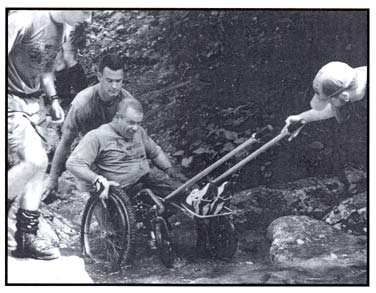
Trailblazing along Gail River Trail. Photograph by Northeast
Passage, a program of the University of New Hampshire
|
Stretching for 56 miles and nestled deep within the alpine embrace of New Hampshire's White Mountain National Forest is a unique network of ten huts-each a day's hike apart. The wood-shingled huts serve as way stations for both day hikers and hardier souls traversing the 2,000 mile-long Appalachian Trail that begins in Georgia and ends in Maine (www.wemedia.com, September 6, 2000). The mountain huts are maintained by the Appalachian Mountain Club (AMC). The AMC is the oldest conservation organization in the United States and has worked since 1876 to protect wilderness areas (Boston Sunday Globe, April 22, 2001).
Located at the end of a rugged 4.6 mile trail at an elevation of 3,800 feet, the Galehead hut is the most remote within AMC's White Mountain network. Although the AMC encourages involvement of all people in its mission and activities, accessibility became an issue recently as the Club was in the process of rebuilding the Galehead hut. The U.S. Forest Service informed the AMC that the hut must conform to the Americans with Disabilities Act's (ADA) accessibility requirements. To make the 38-bed hut accessible, it cost the AMC an additional $50,000 beyond the initial cost of $400,000 to include a ramp along with widened hallways and the elimination of steps up to the bathrooms.
Some AMC members and New Hampshire state newspapers ridiculed the new hut, calling it a waste of money. Further, some maintained that no one in a wheelchair could get to the remote mountain hut.
On the morning of August 15, 2000, three hikers in wheelchairs, two hikers on crutches, and their 20-member support crew of family, friends, and volunteers set out on what would become an historic hike to prove the naysayers wrong. The hike, organized by Northeast Passage, a University of New Hampshire-based outdoor recreation program for individuals with disabilities, received national attention and front-page coverage in The New York Times (August 17,2000).
The 12-hour ascent up the mountain trail-which critics said individuals with disabilities would never use-began through mud and over slippery boulders, thick roots, and narrow bridges. In addition to ropes, spare wheels, tents, and sleeping bags, the hikers devised a variety of techniques. For example, two metal rickshaw poles were added to the front of wheelchairs, thus enabling two people to lift the front casters over rocks and boulders. Wooden planks were also laid over brook crossings and rough ground to facilitate mobility.
All reached the hut by sundown. The hike-one that generally takes a non-disabled hiker three and one-half hours to complete-was completed in 12 hours.
With their accomplishment, challenges were raised and opposing views voiced. In a letter to the Editor of The New York Times (August 21,2000), Dan Bruce, who founded the Center for Appalachian Trail Studies wrote- "Wheelchairs do incredible damage to trails in these fragile areas. Did anyone in the group do an environmental assessment before attempting the exploit or consider that the damage done to the trail by their wheeled equipment may take years for nature to repair?" Further, a local television reporter asked- "Why people in wheelchairs could drag themselves up the trail and not drag themselves up the steps to the hut" (The Union Leader, August 18, 2ooo)?
U.S. Forest Service officials say they have no plans to pave trails or significantly change the wilderness experience. Over the past eight years, the Eastern Region of the Forest Service expended 18 million dollars to improve accessibility. Moreover, the federal government has recently formed an advisory committee to establish standards and create a plan as to how to enforce the ADA in the back country. Janet A. Zeller, who oversees the Forest Service plan on accessibility said, "When you get to a person-built facility, you're beyond what nature has put there... therefore it needs to meet a standard so that when you get to a structure you know what to expect" (AMC Outdoors Magazine, October, 2000).
The trek to the Galehead hut was certainly an accomplishment for individuals with disabilities, and it was sufficiently interesting to be newsworthy. But isn't it advisable to call for the use of adaptive devices as an alternative to wheelchair mobility? In recent years, such devices have been designed to enable people with significant disabilities the opportunity to gain wilderness access in a more environmentally friendly manner (Sports. 'N Spokes, December, 1999). Shouldn't minimum impact to the environment and safety of all those involved be balanced equally with one's right to access?